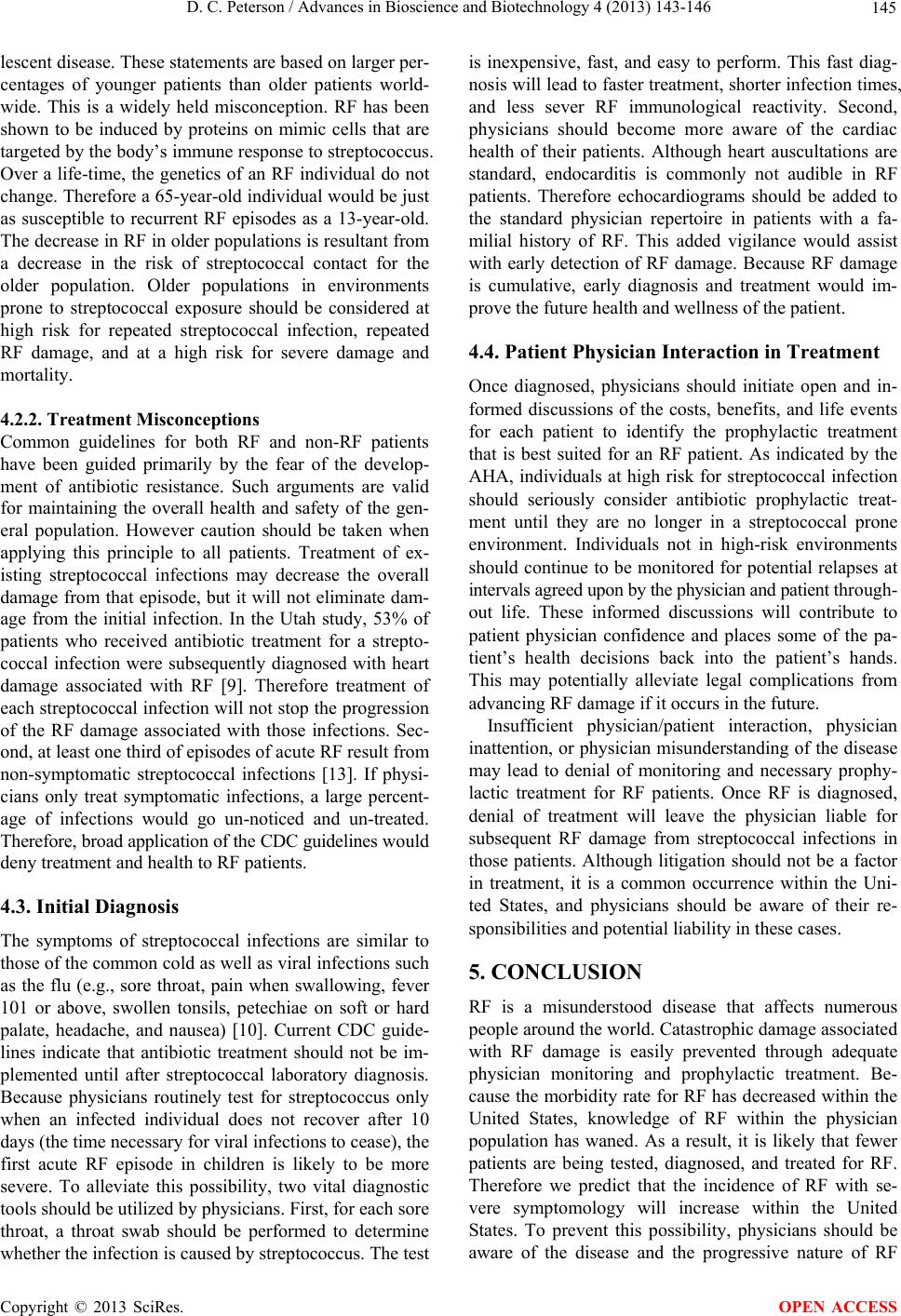
D. C. Peterson / Advances in Bioscience and Biotechnology 4 (2013) 143-146 145
lescent disease. These statements are based on larger per-
centages of younger patients than older patients world-
wide. This is a widely held misconception. RF has been
shown to be induced by proteins on mimic cells that are
targeted by the body’s immune response to streptococcus.
Over a life-time, the genetics of an RF individual do not
change. Therefore a 65-year-old individual would be just
as susceptible to recurrent RF episodes as a 13-year-old.
The decrease in RF in older populations is resultant from
a decrease in the risk of streptococcal contact for the
older population. Older populations in environments
prone to streptococcal exposure should be considered at
high risk for repeated streptococcal infection, repeated
RF damage, and at a high risk for severe damage and
mortality.
4.2.2. Treatment Misconceptions
Common guidelines for both RF and non-RF patients
have been guided primarily by the fear of the develop-
ment of antibiotic resistance. Such arguments are valid
for maintaining the overall health and safety of the gen-
eral population. However caution should be taken when
applying this principle to all patients. Treatment of ex-
isting streptococcal infections may decrease the overall
damage from that episode, but it will not eliminate dam-
age from the initial infection. In the Utah study, 53% of
patients who received antibiotic treatment for a strepto-
coccal infection were subsequently diagnosed with heart
damage associated with RF [9]. Therefore treatment of
each streptococcal infection will not stop the progression
of the RF damage associated with those infections. Sec-
ond, at least one third of episodes of acute RF result from
non-symptomatic streptococcal infections [13]. If physi-
cians only treat symptomatic infections, a large percent-
age of infections would go un-noticed and un-treated.
Therefore, broad application of the CDC guidelines would
deny treatment and health to RF patients.
4.3. Initial Diagnosis
The symptoms of streptococcal infections are similar to
those of the common cold as well as viral infections such
as the flu (e.g., sore throat, pain when swallowing, fever
101 or above, swollen tonsils, petechiae on soft or hard
palate, headache, and nausea) [10]. Current CDC guide-
lines indicate that antibiotic treatment should not be im-
plemented until after streptococcal laboratory diagnosis.
Because physicians routinely test for streptococcus only
when an infected individual does not recover after 10
days (the time necessary for viral infections to cease), the
first acute RF episode in children is likely to be more
severe. To alleviate this possibility, two vital diagnostic
tools should be utilized by physicians. First, for each sore
throat, a throat swab should be performed to determine
whether the infection is caused by streptococcus. The test
is inexpensive, fast, and easy to perform. This fast diag-
nosis will lead to faster treatment, shorter infectio n times,
and less sever RF immunological reactivity. Second,
physicians should become more aware of the cardiac
health of their patients. Although heart auscultations are
standard, endocarditis is commonly not audible in RF
patients. Therefore echocardiograms should be added to
the standard physician repertoire in patients with a fa-
milial history of RF. This added vigilance would assist
with early detection of RF damage. Because RF damage
is cumulative, early diagnosis and treatment would im-
prove the future health and wellness of the patient.
4.4. Patient Physician Interaction in Treatment
Once diagnosed, physicians should initiate open and in-
formed discussions of the costs, benefits, and life events
for each patient to identify the prophylactic treatment
that is best suited for an RF patient. As indicated by the
AHA, individuals at high risk for streptococcal infection
should seriously consider antibiotic prophylactic treat-
ment until they are no longer in a streptococcal prone
environment. Individuals not in high-risk environments
should continue to be monitored for potential relapses at
intervals agreed upon by the physician and patient through-
out life. These informed discussions will contribute to
patient physician confidence and places some of the pa-
tient’s health decisions back into the patient’s hands.
This may potentially alleviate legal complications from
advancing RF damage if it occurs in the future.
Insufficient physician/patient interaction, physician
inattention, or ph ysician misunderstanding of the disease
may lead to denial of monitoring and necessary prophy-
lactic treatment for RF patients. Once RF is diagnosed,
denial of treatment will leave the physician liable for
subsequent RF damage from streptococcal infections in
those patients. Although litigation should not be a factor
in treatment, it is a common occurrence within the Uni-
ted States, and physicians should be aware of their re-
sponsibilities and potential liability in these cases.
5. CONCLUSION
RF is a misunderstood disease that affects numerous
people around the wo rld. Catastrophic damage associated
with RF damage is easily prevented through adequate
physician monitoring and prophylactic treatment. Be-
cause the morbidity rate for RF has decreased within the
United States, knowledge of RF within the physician
population has waned. As a result, it is likely that fewer
patients are being tested, diagnosed, and treated for RF.
Therefore we predict that the incidence of RF with se-
vere symptomology will increase within the United
States. To prevent this possibility, physicians should be
aware of the disease and the progressive nature of RF
Copyright © 2013 SciRes. OPEN ACCESS